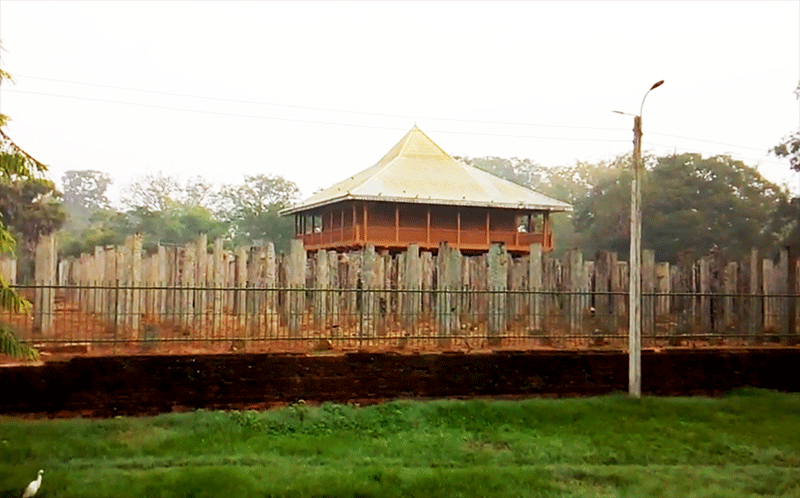The mysterious palace of maha vihara monks: the brazen palace
Brazen palace had been one of the biggest constructions in the ancient city, it was even bigger than the taller structures such as Abhayagiri, Jetawanarama and Ruwanweli stupa on the island for over a millennium between 155BC and 993AD.
In the northern dry plains of Sri Lanka, making the northernmost tip of Sri Lanka’s cultural triangle stands one of the most important historical cities of Sri Lanka, known as Anuradhapura. This historical city is one of the greatest ancient treasures in Sri Lanka: hundreds of well preserved ancient historical constructions spread over 40 sq.km and their origin go back to 3rd century BC to 10th century AD. Due to the highest historical importance, Anuradhapura has become one of the major tourist places in Sri Lanka and included in most Sri Lanka trips such as 5 days Sri Lanka trip to the cultural triangle.
The city had been a well-planned city with Buddhist temples, Royal palaces, audience halls, parks, reservoirs and many other constructions. According to the estimation of archaeologists, it was inhabitant by a large number of people.
The north-central part of Sri Lanka is categorized under the dry-zone. Most part of the region gets rainwater only during a short period of time during the year. Therefore, water shortage is a severe problem that people facing here. The dry-zone get about 1500 mm of rainfall every year.
Yet, Anuradhapura was the capital of ancient Sri Lanka. It was the living quarter of one of the thriving ancient civilization-the Sinhalese that is the origin of the majority of Sri Lankan people.
Lovamahapaya or Brazen palace
Lovamahapaya, Lowamahaprasada or brazen palace had been a multi-storied building with 1000 rooms. It had been Uposathagara (Uposatha house). It was also used as a refectory in ancient time. Much of the ancient building had been destroyed over last millennia. Only the granite pillars, that were once holding the magnitude building are remarkably well-preserved.
Using granite stones is a common practice in the ancient Kings of Sri Lanka. Especially during the Anuradhapura period from 3rd century BC to 10th century AD. From the floor mats, which located at the entrance of image house to the balustrade and the foundations as well as the main structures of the buildings were constructed using granite stones.
The brazen palace had been a part of the temple complex, Mahavihara and it was constructed under the leadership of King Dutugemunu in 2nd century BC. The roof of the temple had been covered with tiles made of Brass. The brass roof was shining very brightly and could be witnessed from far away places. Therefore, the palace became popular as the brazen palace.
Brazen palace had been one of the biggest constructions in the ancient city, it was even bigger than the taller structures such as Abhayagiri, Jetawanarama and Ruwanweli stupa on the island for over a millennium between 155BC and 993AD.
The entire city, including the brazens palace and other ancient constructions, was hidden in the thick jungle until they were encountered by the British archaeologists in the early 18s. After ascertaining its historical value, the British administration started to excavate the entire city including the site of Lovamhapaya, and they discovered many thousands of archaeological sites as well as more than 1500 man-made lakes. Anuradhapura is the large archaeological site in Sri Lanka, which expands over a 40 sq. km.
According to the estimation of archaeologists, it was 9 storied building with 1000 rooms for monks. The construction of the brazen palace laster 6 years. A building in such a magnitude size without any machinery is a remarkable achievement. The plan of the temple should have come from heaven, according to the chronicles.
The brazen palace was completely destroyed, during the reign of King Saddhatissa, due to a fire. The temple was reconstructed under the leadership of King Parakramabahu. The building was lavishly decorated with corals and gemstone and intricate wood carvings.
Where is Brazen palace located
Lovamahapaya or Brazen palace is located at the heart of the ancient city, between Sri Maha bodhi and Ruwanweli stupa. Today, the visitors can wander around the site, that was dedicated to the Lovamahapaya and the walkways used by inhabitants of the temple 2000 years ago.
A large part of the brazen palace was destroyed for a long time ago, only the foundation remains at the site. Approximately 1600 granite pillars were used as the foundation of the ancient building. The length of the building was 400 ft (120 m). There had been 40 rows of stone pillars, and each raw was consisting of 4o pillars.
Gigantic pillars are presumably hewn by the stonemasons by hand. Where the stone pillars were originated is not known to most people. However, archaeologists believe that stone pillars were constructed outside of the city and brought to the ancient city using elephants.
According to the historians Lovamahapaya was built for the monks of Mahavihara temple complex. The Lovamahapaya is located close to the most sacred religious site in the ancient city of the Anuradhapura, which is the Sri Maha Bodhi. According to the historical evidence, the daily rituals of Sri Maha bodhi was entrusted on the monks lived in the brazen palace. The monks that resided in the Lovamahapaya believed to be helping the Buddhist devotees, who were coming to Sri Maha bodhi to venerate the sacred tree.
A part of the brazen palace was, called Simamlaka, which had been used as the assembling point for the sermon on full moon days. Presumably, the monks recited the sutra of the confessional in the early days at the Simamalaka.






